American Le Mans theme by ryanindy124
Download: AmericanLeMans.p3t
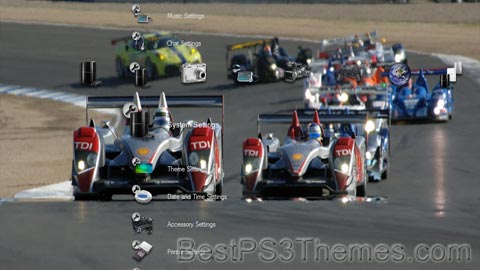
(6 backgrounds)
Redirect to:

The #1 spot for Playstation themes!
Kevin Harvick theme by ryanindy124
Download: KevinHarvick.p3t
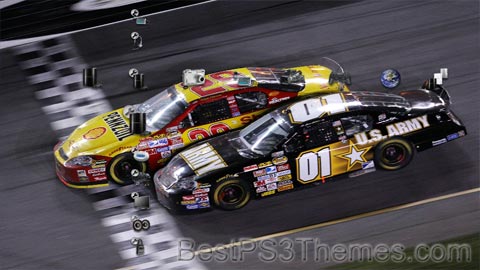
(6 backgrounds)
Kevin Michael Harvick (born December 8, 1975) is an American semi-retired professional stock car racing driver and commentator for NASCAR on Fox.
He last competed full-time in the NASCAR Cup Series, driving the No. 4 Ford Mustang for Stewart–Haas Racing. Harvick won the Cup Series championship in 2014 as well as the 2001 and 2006 Xfinity Series championships, and the 2007 Daytona 500. Harvick holds the all-time record for Cup Series wins at Phoenix Raceway with nine wins. Harvick's 121 combined national series wins currently rank him third all-time in NASCAR history, behind Richard Petty and Kyle Busch, respectively, while his 60 Cup wins are tenth in series history. Harvick began his NASCAR career in 1992, he is the third of only six drivers that have won a championship in both the Cup Series and the Xfinity Series, and the fifth of 36 drivers to win a race in each of NASCAR's three national series. Harvick has worked as a broadcaster off-and-on for NASCAR on FOX since 2015, calling Xfinity Series races. Since retiring from NASCAR Cup Series competition, Harvick is signed to call Cup Series races for Fox starting in 2024.
Harvick is the owner of Kevin Harvick Incorporated, a race team that fielded cars in the Xfinity Series from 2004 to 2011 and the Truck Series between 2001 and 2011. The team's No. 29 late model is driven full-time in the CARS Tour by Brent Crews, alongside the No. 62 late model which is driven by several different drivers, including Harvick himself. In the media, he has sometimes been nicknamed "the Closer" and "Happy Harvick."
Harvick was born in 1975 in Bakersfield, California, to parents Mike and JoNell (Walker) Harvick, and has a younger sister, Amber. He began kart racing at an early age, after his parents bought him a go-kart as a kindergarten graduation gift.[1] Harvick grew up a fan of IndyCar driver and fellow Bakersfield native Rick Mears, and raced go-karts with Mears' son Clint.[2] He achieved considerable success on the go-kart racing circuit, earning seven national championships and two Grand National championships.[3]
While in high school, Harvick began racing late models part-time in 1992 in the NASCAR Featherlite Southwest Series.[4] During the racing offseason, he competed on the North High School wrestling team, qualifying for a CIF Central Section title in his weight class his senior year.[5] Harvick also played baseball, basketball, football, and soccer.[4] After graduation, he attended Bakersfield College with the intention of majoring in architecture,[4] but later dropped out in order to pursue a full-time racing career.[1]
Harvick made his Craftsman Truck Series debut in 1995 at the Mesa Marin Raceway, in his hometown of Bakersfield, where he started and finished 27th in his family-owned No. 72. He drove four races in the No. 72 the next season, his best finish was 11th at Mesa Marin. In 1997, he signed to drive the No. 75 for Spears Motorsports mid-season, posting two eighth-place finishes. He ran a full schedule the next season, posting 3 top-fives and finishing 17th in points. Harvick also moved up to the NASCAR Grand National Division, AutoZone West Series in 1997, and in 1998 Harvick won five races on his way to the Winston West Series championship while driving for Spears. He received his first real national exposure during the winter of 1997/1998 on ESPN2's coverage of the NASCAR Winter Heat Series at Tucson Raceway Park. In 1999, he drove the No. 98 Porter Cable Ford for Liberty Racing, finishing 12th in points with six top-fives.
On October 23, 1999, Harvick made his first NASCAR Busch Series start in the Kmart 200 at the Rockingham Speedway in the No. 2 Chevrolet. He would start 24th and finish 42nd due to engine failure. The race would be his only start in 1999. In 2000, Harvick would sign with Richard Childress Racing to drive the No. 2 Chevrolet for his first full Busch Series season. Despite failing to qualify for the second race of the season at Rockingham, Harvick would go on to win the NASCAR Busch Series Rookie of the Year with three wins, eight top-five finishes, and 16 top-tens as well as garnering third-place points finish.

For 2001, Childress planned to run Harvick in the No. 2 Chevy in the Busch Series full-time again, while developing him into the Winston Cup Series with up to seven races in the No. 30 Chevy. He planned to race Harvick for a full schedule in 2002. The death of Dale Earnhardt on the last lap of the 2001 Daytona 500 changed Childress's plans, and Harvick began his first Cup race the following week in the Dura Lube 400 at Rockingham, filling the seat vacated by Earnhardt's passing in the renumbered No. 29 Chevrolet.
On March 11, 2001, in the Cracker Barrel Old Country Store 500 at Atlanta Motor Speedway, only three weeks after Earnhardt's death, Harvick won his first career Winston Cup race in just his third start by narrowly edging Jeff Gordon. He won the race by only six one-thousandths of a second (.006). After the win, he paid tribute to Earnhardt, driving on the track backward with three fingers held aloft outside the driver's window as a show of honor and respect.[6] At the time, this broke the record for earliest career start for a driver to win a race in the Modern Era, since surpassed by Jamie McMurray and Trevor Bayne, both of whom accomplished the feat in their second starts, and then by Shane van Gisbergen in 2023 in his debut.
He won his second career Cup race at Chicagoland Speedway in Joliet, Illinois.[7] At the end of the season, he finished with two victories, six Top 5s, and 16 Top 10s. Harvick was awarded the NASCAR Rookie of the Year Award and secured a ninth-place finish in the 2001 points standings. He also won the Busch Series championship, becoming the first driver to win the Busch Series championship while also driving full-time in the Winston Cup Series with a Top 10 finish. Harvick would end the season winning six pole positions, and making 69 starts: 35 in Cup Series, an appearance in the Winston, 33 in the Busch Series, and one in the Craftsman Truck Series at Richmond International Raceway for Rick Carelli.
In 2002, Harvick spent the season concentrating on running the Cup Series and would only start four races in the Busch Series. Harvick began the 2002 season making his first Daytona 500 start on the outside pole next to Jimmie Johnson, but his day ended after triggering an 18-car crash on lap 148 while running second to Jeff Gordon, relegating him to a 36th-place finish. Later in the season, he was fined for a post-race incident with Greg Biffle at Bristol Motor Speedway. Harvick was also suspended for rough driving in a Truck race at Martinsville, in which he announced on his radio that he intentionally spun out driver Coy Gibbs, prompting NASCAR to immediately take him out of the race. Even though it was heard on the radio that he did, Harvick lied in a post-race interview saying that he did not purposely wreck Gibbs. Harvick was banned from the Cup Series race the next day, with Kenny Wallace replacing him; he was also fined $35,000 and placed into another probation (he was already on probation for the Biffle incident).[8] Harvick rebounded and scored his first career Winston Cup pole position in the Pepsi 400 at Daytona. Later in the season, he took his third Cup win at Chicagoland Speedway. This would prove to be one of the only bright spots in a disappointing season, as he finished 21st in the 2002 points standings with one win, one pole, five Top 5s, and eight Top 10s. Harvick became the 2002 IROC Champion in his first season in the Series, winning at California Speedway. In Trucks, Harvick began fielding his own No. 6 truck, driving himself in five races and winning at Phoenix.

In the 2003 season, Harvick teamed with crew chief Todd Berrier in the Cup Series, with whom he had won the Busch championship in 2001. Together, they won the Brickyard 400 at Indianapolis. Harvick and his team jumped to fifth in the 2003 point standings, coming within 252 points of Matt Kenseth. In the Busch Series, Harvick was teamed with Johnny Sauter, driving the No. 21 Hershey's-sponsored PayDay car. The two would combine for three wins, 16 Top 5s, and 24 Top 10s, with Harvick posting all three wins. They would give Childress the NASCAR Busch Series owners' championship that season. Harvick competed in 19 of the 34 races, and Sauter competed in the other 15. Harvick also scored eight pole positions and finished 16th in the final drivers' standings.
On August 28 during the 2004 Sharpie 500 at Bristol Motor Speedway, Harvick had one of the most bizarre sequences of events happen to him. On lap 323, Harvick radioed to his crew that his right arm had fallen asleep on him and had gone numb which made it difficult for him to operate his race car properly and needed a backup driver. The caution came out 5 laps later and Harvick made his way onto pit road and was pulled out of the car. He was replaced by Kyle Petty, who was involved in an earlier wreck in the same race. Petty finished 24th 6 laps down for Harvick.[9] Harvick was still able to stay 8th in points but in the last 2 regular season races at California and Richmond, Harvick would fall from 8th to 15th in the standings missing out on the inaugural Chase for the Cup. Harvick's season was also known for his conflicts with Matt Kenseth at Pocono and rookie Kasey Kahne at Phoenix.[10][11] While winless in the 2004 Cup season, Harvick placed third in the voting for Most Popular Driver. He had fourteen Top 10 finishes and finished 14th in points. Harvick was paired with another driver in the Busch Series, rookie Clint Bowyer. They combined for one win, 13 Top 5s, and 20 Top 10s in the No. 21 car, with Reese's Peanut Butter Cups as a sponsor. Harvick drove the No. 29 Busch car in the final race of the season at Homestead–Miami Speedway in the Ford 300, which he would claim his second win of the season. He finished 14th in the final standings. The No. 21 car finished fourth in the owner's standings.
In the 2005 season, Harvick's only Cup win came at the Food City 500 at Bristol Motor Speedway, despite starting towards the rear of the field. He won without the assistance of crew chief Todd Berrier, who was serving a four-week suspension for a rules violation. In the Busch Series, Harvick was paired with Brandon Miller. Harvick and Miller combined for 3 wins, 15 top-fives, and 19 top-tens to give the No. 21 its second fourth-place finish in the owner's standings. Harvick would win his first "sweep" of his career at Bristol, winning both the Sharpie Professional 250 Busch race and the Food City 500 Cup race, also giving him a record fourth Busch Series win at the track (tying with Morgan Shepherd). Harvick finished 14th in the Cup series standings and 18th in the Busch series driver's standings.

In 2006, Harvick decided to run both of NASCAR's Top 2 series full-time driving for Richard Childress. In the Busch Series, Harvick would be scheduled to run all 35 races, with three different cars. He ran four races for his team in the No. 33, the season opener at Daytona in Childress' No. 29, and the remaining 30 races for RCR's No. 21. He won his first Busch Series race of the 2006 season at Nashville Superspeedway. He followed the win with a weekend sweep of the Busch Series and Sprint Cup races at Phoenix International Raceway. Harvick had nine wins, 23 Top 5s, and 32 Top 10s in the Busch Series. He clinched the 2006 NASCAR Busch Series championship on October 13, 2006, at Lowe's Motor Speedway in the Dollar General 300. It was the earliest clinch of the championship ever in the Busch Series, locking up the title with four races to go. He ended the season with a record 824-point margin in the final standings.
In the Nextel Cup series, Harvick, along with teammate Jeff Burton, scored the first berths for Richard Childress Racing in the Chase for the Cup. Harvick would have 3 wins, 11 top-5's and 14 top-10s going into the chase.

After a dominant win at New Hampshire, Harvick would have a substandard Chase run. He fell to sixth place in the point standings until he finished third at Texas. Following that was another dominating performance in the Checker Auto Parts 500 at Phoenix International Raceway on November 12. Harvick would win that race, moving him up to third in points. At the season finale at Homestead-Miami Speedway, Harvick would finish fifth in the race and slip to fourth in the final standings to eventual 2006 NASCAR Sprint Cup Series champion Jimmie Johnson.
Harvick opened the 2007 Sprint Cup series with a dramatic final lap pass in the Daytona 500, beating Mark Martin by .020 seconds in a green-white-checkered finish, the closest margin at the 500 since electronic scoring started in 1993. He would become only the fourth NASCAR driver to sweep both the Nationwide and Cup races in the opening weekend at Daytona. With the win, Harvick also became the sixth of eight drivers to win both the Daytona 500 and the Brickyard 400, following Jeff Gordon, Dale Earnhardt, Dale Jarrett, Bill Elliott, Jimmie Johnson, and preceding Jamie McMurray and Ryan Newman.[12][13] Harvick would be quiet for the remainder of the season, his only other win coming in the Sprint All-Star Race and finishing 10th in points.
In 2007, Harvick started the Nationwide Series season by winning the Orbitz 300 at Daytona, claiming his first win in a restrictor-plate race, as well as the first win for new sponsor AutoZone in NASCAR's Nationwide Series. He also won at New Hampshire International Speedway, winning the Camping World 200 presented by RVs.com. He also ended up unexpectedly winning the inaugural race at Montreal in August, the NAPA Auto Parts 200, after with two laps to go, leader Robby Gordon was black-flagged for intentionally causing a crash involving rookie Marcos Ambrose. The win was considered a bit of an upset as many expected the road course ringers to dominate and Harvick had started 43rd in the race due to a driver change.[14]

Harvick went winless in 2008, but he was still able to post a fourth-place ranking in the 2008 Chase for the Sprint Cup. The fourth-place finish in the 2008 standings tied 2006 for his highest points position at the end of the season. Harvick also went the entire season without a single DNF for the second straight year. In the Nationwide Series, he ran twenty-two races for his team with sponsorship from Camping World, Rheem, and RoadLoans. He did not win a race in this series either. His lone win came in a Truck race at Phoenix.
Ferrari theme by stu2b
Download: Ferrari_3.p3t
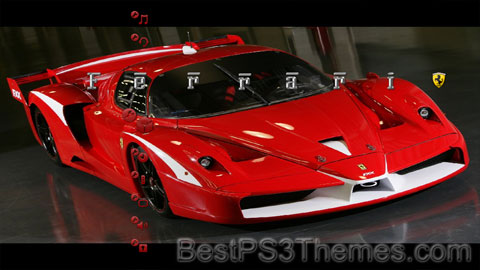
(5 backgrounds)
 | |
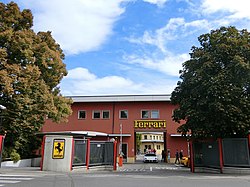 Headquarters in Maranello, Italy | |
| Company type | Public (S.p.A.) |
|---|---|
| ISIN | NL0011585146 |
| Industry | Automotive |
| Founded | 13 September 1939 in Modena, Italy (as Auto Avio Costruzioni)[1] |
| Founder | Enzo Ferrari |
| Headquarters |
44°31′57″N 10°51′51″E / 44.532447°N 10.864137°E |
Area served | Worldwide |
Key people |
|
| Products | Sports cars, luxury cars |
Production output | |
| Revenue | |
| Total assets | |
| Total equity | |
| Owners | |
Number of employees | |
| Divisions | Scuderia Ferrari |
| Website | www |
| Footnotes / references [3] [4][5] | |
Ferrari S.p.A. (/fəˈrɑːri/; Italian: [ferˈraːri]) is an Italian luxury sports car manufacturer based in Maranello. Founded in 1939 by Enzo Ferrari (1898–1988), the company built its first car in 1940, adopted its current name in 1945, and began to produce its current line of road cars in 1947. Ferrari became a public company in 1960, and from 1963 to 2014 it was a subsidiary of Fiat S.p.A. It was spun off from Fiat's successor entity, Fiat Chrysler Automobiles, in 2016. In 2024, the Wall Street Journal described the company as having been "synonymous with opulence, meticulous craftsmanship and ridiculously fast cars for nearly a century".[6]
The company currently offers a large model range which includes several supercars, grand tourers, and one SUV. Many early Ferraris, dating to the 1950s and 1960s, count among the most expensive cars ever sold at auction. Owing to a combination of its cars, enthusiast culture, and successful licensing deals, in 2019 Ferrari was labelled the world's strongest brand by the financial consultancy Brand Finance.[7] As of May 2023, Ferrari is also one of the largest car manufacturers by market capitalisation, with a value of approximately US$52 billion.[8]
Throughout its history, the company has been noted for its continued participation in racing, especially in Formula One, where its team, Scuderia Ferrari, is the series' single oldest and most successful. Scuderia Ferrari has raced since 1929, first in Grand Prix events and later in Formula One, where since 1952 it has fielded fifteen champion drivers, won sixteen Constructors' Championships, and accumulated more race victories, 1–2 finishes, podiums, pole positions, fastest laps and points than any other team in F1 history.[9][10] Historically, Ferrari was also highly active in sports car racing, where its cars took many wins in races such as the Mille Miglia, Targa Florio and 24 Hours of Le Mans, as well as several overall victories in the World Sportscar Championship. Scuderia Ferrari fans, commonly called tifosi, are known for their passion and loyalty to the team.

Enzo Ferrari, formerly a salesman and racing driver for Alfa Romeo, founded Scuderia Ferrari, a racing team, in 1929. Originally intended to service gentleman drivers and other amateur racers, Alfa Romeo's withdrawal from racing in 1933, combined with Enzo's connections within the company, turned Scuderia Ferrari into its unofficial representative on the track.[11] Alfa Romeo supplied racing cars to Ferrari, who eventually amassed some of the best drivers of the 1930s and won many races before the team's liquidation in 1937.[11][12]: 43
Late in 1937, Scuderia Ferrari was liquidated and absorbed into Alfa Romeo,[11] but Enzo's disagreements with upper management caused him to leave in 1939. He used his settlement to found his own company, where he intended to produce his own cars. He called the company "Auto Avio Costruzioni", and headquartered it in the facilities of the old Scuderia Ferrari;[1] due to a noncompete agreement with Alfa Romeo, the company could not use the Ferrari name for another four years. The company produced a single car, the Auto Avio Costruzioni 815, which participated in only one race before the outbreak of World War II. During the war, Enzo's company produced aircraft engines and machine tools for the Italian military; the contracts for these goods were lucrative, and provided the new company with a great deal of capital. In 1943, under threat of Allied bombing raids, the company's factory was moved to Maranello. Though the new facility was nonetheless bombed twice, Ferrari remains in Maranello to this day.[1][12]: 45–47 [13]

In 1945, Ferrari adopted its current name. Work started promptly on a new V12 engine that would power the 125 S, which was the marque's first car, and many subsequent Ferraris. The company saw success in motorsport almost as soon as it began racing: the 125 S won many races in 1947,[16][17] and several early victories, including the 1949 24 Hours of Le Mans and 1951 Carrera Panamericana, helped build Ferrari's reputation as a high-quality automaker.[18][19] Ferrari won several more races in the coming years,[9][20] and early in the 1950s its road cars were already a favourite of the international elite.[21] Ferrari produced many families of interrelated cars, including the America, Monza, and 250 series, and the company's first series-produced car was the 250 GT Coupé, beginning in 1958.[22]
In 1960, Ferrari was reorganized as a public company. It soon began searching for a business partner to handle its manufacturing operations: it first approached Ford in 1963, though negotiations fell through; later talks with Fiat, who bought 50% of Ferrari's shares in 1969, were more successful.[23][24] In the second half of the decade, Ferrari also produced two cars that upended its more traditional models: the 1967 Dino 206 GT, which was its first mass-produced mid-engined road car,[a] and the 1968 365 GTB/4, which possessed streamlined styling that modernised Ferrari's design language.[27][28] The Dino in particular was a decisive movement away from the company's conservative engineering approach, where every road-going Ferrari featured a V12 engine placed in the front of the car, and it presaged Ferrari's full embrace of mid-engine architecture, as well as V6 and V8 engines, in the 1970s and 1980s.[27]
Enzo Ferrari died in 1988, an event that saw Fiat expand its stake to 90%.[29] The last car that he personally approved—the F40—expanded on the flagship supercar approach first tried by the 288 GTO four years earlier.[30] Enzo was replaced in 1991 by Luca Cordero di Montezemolo, under whose 23-year-long chairmanship the company greatly expanded. Between 1991 and 2014, he increased the profitability of Ferrari's road cars nearly tenfold, both by increasing the range of cars offered and through limiting the total number produced. Montezemolo's chairmanship also saw an expansion in licensing deals, a drastic improvement in Ferrari's Formula One performance (not least through the hiring of Michael Schumacher and Jean Todt), and the production of three more flagship cars: the F50, the Enzo, and the LaFerrari. In addition to his leadership of Ferrari, Montezemolo was also the chairman of Fiat proper between 2004 and 2010.[31]
After Montezemolo resigned, he was replaced in quick succession by many new chairmen and CEOs. He was succeeded first by Sergio Marchionne,[31] who would oversee Ferrari's initial public offering and subsequent spin-off from Fiat Chrysler Automobiles,[32][33] and then by Louis Camilleri as CEO and John Elkann as chairman.[34] Beginning in 2021, Camilleri was replaced as CEO by Benedetto Vigna, who has announced plans to develop Ferrari's first fully electric model.[35] During this period, Ferrari has expanded its production, owing to a global increase in wealth, while becoming more selective with its licensing deals.[36][37]
Since the company's beginnings, Ferrari has been involved in motorsport. Through its works team, Scuderia Ferrari, it has competed in a range of categories including Formula One and sports car racing, though the company has also worked in partnership with other teams.

The earliest Ferrari entity, Scuderia Ferrari, was created in 1929—ten years before the founding of Ferrari proper—as a Grand Prix racing team. It was affiliated with automaker Alfa Romeo, for whom Enzo had worked in the 1920s. Alfa Romeo supplied racing cars to Ferrari, which the team then tuned and adjusted to their desired specifications. Scuderia Ferrari was highly successful in the 1930s: between 1929 and 1937 the team fielded such top drivers as Antonio Ascari, Giuseppe Campari, and Tazio Nuvolari, and won 144 out of its 225 races.[12][11]
Ferrari returned to Grand Prix racing in 1947, which was at that point metamorphosing into modern-day Formula One. The team's first homebuilt Grand Prix car, the 125 F1, was first raced at the 1948 Italian Grand Prix, where its encouraging performance convinced Enzo to continue the company's costly Grand Prix racing programme.[38]: 9 Ferrari's first victory in an F1 series was at the 1951 British Grand Prix, heralding its strong performance during the 1950s and early 1960s: between 1952 and 1964, the team took home six World Drivers' Championships and one Constructors' Championship. Notable Ferrari drivers from this era include Alberto Ascari, Juan Manuel Fangio, Phil Hill, and John Surtees.[9]
Ferrari's initial fortunes ran dry after 1964, and its began to receive its titles in isolated sprees.[10] Ferrari first started to slip in the late 1960s, when it was outclassed by teams using the inexpensive, well-engineered Cosworth DFV engine.[39][40] The team's performance improved markedly in the mid-1970s thanks to Niki Lauda, whose skill behind the wheel granted Ferrari a drivers' title in 1975 and 1977; similar success was accomplished in following years by the likes of Jody Scheckter and Gilles Villeneuve.[10][41] The team also won the Constructors' Championship in 1982 and 1983.[9][42]
Following another drought in the 1980s and 1990s, Ferrari saw a long winning streak in the 2000s, largely through the work of Michael Schumacher. After signing onto the team in 1996, Schumacher gave Ferrari five consecutive drivers' titles between 2000 and 2004; this was accompanied by six consecutive constructors' titles, beginning in 1999. Ferrari was especially dominant in the 2004 season, where it lost only three races.[9] After Schumacher's departure, Ferrari won one more drivers' title—given in 2007 to Kimi Räikkönen—and two constructors' titles in 2007 and 2008. These are the team's most recent titles to date; as of late, Ferrari has struggled to outdo recently ascendant teams such as Red Bull and Mercedes-Benz.[9][10]
Ferrari's junior driver programme is the Ferrari Driver Academy. Begun in 2009, the initiative follows the team's successful grooming of Felipe Massa between 2003 and 2006. Drivers who are accepted into the Academy learn the rules and history of formula racing as they compete, with Ferrari's support, in feeder classes such as Formula Three and Formula 4.[43][44][45] As of 2019, 5 out of 18 programme inductees had graduated and become F1 drivers: one of these drivers, Charles Leclerc, came to race for Scuderia Ferrari, while the other four signed to other teams. Non-graduate drivers have participated in racing development, filled consultant roles, or left the Academy to continue racing in lower-tier formulae.[45]
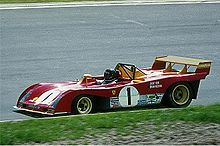
Aside from an abortive effort in 1940, Ferrari began racing sports cars in 1947, when the 125 S won six out of the ten races it participated in. [16] Ferrari continued to see similar luck in the years to follow: by 1957, just ten years after beginning to compete, Ferrari had won three World Sportscar Championships, seven victories in the Mille Miglia, and two victories at the 24 Hours of Le Mans, among many other races[20] These races were ideal environments for the development and promotion of Ferrari's earlier road cars, which were broadly similar to their racing counterparts.[46]
This luck continued into the first half of the 1960s, when Ferrari won the WSC's 2000GT class three consecutive times and finished first at Le Mans for six consecutive years.[47][48] Its winning streak at Le Mans was broken by Ford in 1966,[48] and though Ferrari would win two more WSC titles—one in 1967 and another in 1972[49][50]—poor revenue allocation, combined with languishing performance in Formula One, led the company to cease competing in sports car events in 1973.[24]: 621 From that point onward, Ferrari would help prepare sports racing cars for privateer teams, but would not race them itself.[51]

In 2023, Ferrari reentered sports car racing. For the 2023 FIA World Endurance Championship, Ferrari, in partnership with AF Corse, fielded two 499P sports prototypes. To commemorate the company's return to the discipline, one of the cars was numbered "50", referencing the fifty years that had elapsed since a works Ferrari competed in an endurance race.[52][53] The 499P finished first at the 2023 24 Hours of Le Mans, ending Toyota Gazoo Racing's six-year winning streak there and becoming the first Ferrari in 58 years to win the race.[54]At the 2024 24 Hours of Le Mans, Ferrari achieved its eleventh victory, second consecutive at Le Mans since 1965 with the No. 50 499P driven by Antonio Fuoco, Miguel Molina and Nicklas Nielsen. While the Ferrari No. 51 499P driven by Alessandro Pier Guidi, James Calado, a
Super Cars theme by Deftone
Download: SuperCars.p3t
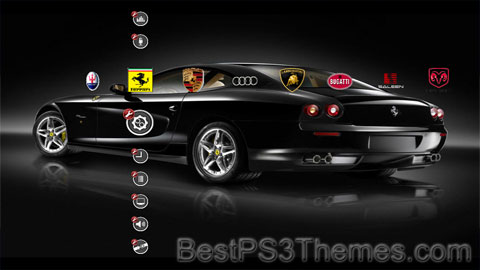
(8 backgrounds)
This article needs additional citations for verification. (July 2023) |
| Super Cars | |
|---|---|
 Title screen | |
| Developer(s) | Magnetic Fields |
| Publisher(s) | Gremlin Graphics Electro Brain (NES version) |
| Composer(s) | NES version Barry Leitch |
| Platform(s) | Amiga, Atari ST, Amstrad CPC, Commodore 64, NES, ZX Spectrum |
| Release | 1990 NA: 1991 (NES) |
| Genre(s) | Sport |
| Mode(s) | Single-player |
Super Cars is a top-view racing game from Gremlin Interactive, who later produced the Lotus series of games. Stylistically, the game is influenced by Super Sprint.[1]
There are endless tracks at each of the 4 difficulty levels, which can be raced in any order (although the last track raced is made harder than usual). In the races the player wins money, which can be spent on temporary handling and power upgrades, plus armour plating and front/rear shooting missiles that can knock out other racers. The player must finish in the top 3 of each race to progress - initially there are 4 computer opponents, but more are added as the game progresses.
The car can be upgraded throughout the game via the shop section. The player is given an initial price, but also a number of options of things to say to the salesman - with the right combination, the price will drop.
The NES version was released exclusively in America in 1991 by Electro Brain.
It was followed by Super Cars II in 1991.
Three cars are available for purchase during the game, the Taraco Neoroder Turbo, the Vaug Interceptor Turbo and the Retron Parsec Turbo. Each appears to be based on a real car of the time with the Retron Parsec Turbo being based on the Cizeta-Moroder V16T, the Vaug Interceptor based on the Honda NSX and the Taraco Neoroder based on the Alfa Romeo SZ (Sprint Zagato) but with some slight changes. This is in slight contrast to the box art, where the blue "starter" car (Taraco) instead more closely resembles a contemporary European Ford Fiesta or Escort Cosworth convertible. The Retron is also portrayed differently on the box art, where it is a Lamborghini Countach instead of a Cizeta.

Mustang theme by wizer238
Download: Mustang.p3t
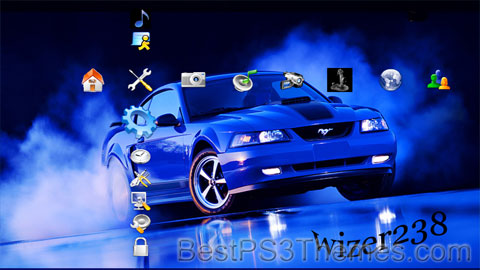
(1 background, wallpaper different for HD and SD)
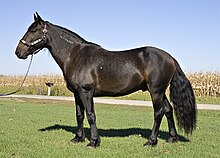 Mustang adopted from the Bureau of Land Management | |
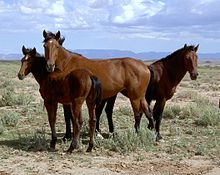 Free-roaming mustangs near Chinle, Arizona | |
| Country of origin | North America |
|---|---|
| Traits | |
| Distinguishing features | Small, compact, good bone, very hardy |
The mustang is a free-roaming horse of the Western United States, descended from horses brought to the Americas by the Spanish conquistadors. Mustangs are often referred to as wild horses, but because they are descended from once-domesticated animals, they are actually feral horses. The original mustangs were Colonial Spanish horses, but many other breeds and types of horses contributed to the modern mustang, now resulting in varying phenotypes. Some free-roaming horses are relatively unchanged from the original Spanish stock, most strongly represented in the most isolated populations.
In 1971, the United States Congress recognized that "wild free-roaming horses and burros are living symbols of the historic and pioneer spirit of the West, which continue to contribute to the diversity of life forms within the Nation and enrich the lives of the American people."[1] The free-roaming horse population is managed and protected by the U.S. Bureau of Land Management (BLM).
Controversy surrounds the sharing of land and resources by mustangs with the livestock of the ranching industry, and also with the methods by which the BLM manages their population numbers. The most common method of population management used is rounding up excess population and offering them to adoption by private individuals. There are inadequate numbers of adopters, so many once free-roaming horses now live in temporary and long-term holding areas with concerns that the animals may be sold for horse meat. Additional debate centers on the question of whether mustangs—and horses in general—are a native species or an introduced invasive species in the lands they inhabit.
Although free-roaming Mustangs are called "wild" horses, they descend from feral domesticated horses.[a]
According to the Oxford English Dictionary (OED), the English word mustang was likely borrowed from two essentially synonymous Spanish words, mestengo (or mesteño) and mostrenco.[4] English lexicographer John Minsheu glossed both words together as 'strayer' in his dictionary of 1599.[4] Both words referred to livestock defined as 'wild, having no master'.[b] Mostrenco was used since the 13th century, while mestengo is attested from the late 15th.[4]
Mesteño referred originally to beasts of uncertain ownership distributed by the powerful transhumant merino sheep ranchers' guild in medieval Spain, called the Mesta (Honrado Concejo de la Mesta, 'Honorable Council of the Mesta').[6][7][4] The name of the Mesta derived ultimately from the Latin: mixta, lit. 'mixed', referring to the common ownership of the guild's animals by multiple parties.[7] The OED states that the origin of mostrenco is "obscure" but notes the Portuguese: mostrengo is attested from the 15th century.[4] In Spanish, mustangs are named mesteños.[citation needed] By 1936, the English 'mustang' had been loaned back into Spanish as mustango.[4]
"Mustangers" (Spanish: mesteñeros) were cowboys (vaqueros) who caught, broke, and drove free-ranging horses to market in the Spanish and later American territories of what is now northern Mexico, Texas, New Mexico, and California. They caught the horses that roamed the Great Plains, the San Joaquin Valley of California, and later the Great Basin, from the 18th century to the early 20th century.[8][9]

The original mustangs were Colonial Spanish horses, but many other breeds and types of horses contributed to the modern mustang, resulting in varying phenotypes. Mustangs of all body types are described as surefooted and having good endurance. They may be of any coat color.[10] Throughout all the Herd Management Areas managed by the Bureau of Land Management, light riding horse type predominates, though a few horses with draft horse characteristics also exist, mostly kept separate from other mustangs and confined to specific areas.[11] Some herds show the signs of the introduction of Thoroughbred or other light racehorse-types into herds, a process that also led in part to the creation of the American Quarter Horse.[12]
The mustang of the modern west has several different breeding populations today which are genetically isolated from one another and thus have distinct traits traceable to particular herds.[citation needed] Genetic contributions to today's free-roaming mustang herds include assorted ranch horses that escaped to or were turned out on the public lands, and stray horses used by the United States Cavalry.[c] For example, in Idaho some Herd Management Areas (HMA) contain animals with known descent from Thoroughbred and Quarter Horse stallions turned out with feral herds.[15] The herds located in two HMAs in central Nevada produce Curly Horses.[16][17] Others, such as certain bands in Wyoming, have characteristics consistent with gaited horse breeds.[18]
Many herds were analyzed for Spanish blood group polymorphism (commonly known as "blood markers") and microsatellite DNA loci.[19] Blood marker analysis verified a few to have significant Spanish ancestry, namely the Cerbat Mustang, Pryor Mountain Mustang, and some horses from the Sulphur Springs HMA.[20] The Kiger Mustang is also said to have been found to have Spanish blood[11][dubious – discuss] and subsequent microsatellite DNA confirmed the Spanish ancestry of the Pryor Mountain Mustang.[21]
Horses in several other HMAs exhibit Spanish horse traits, such as dun coloration and primitive markings.[d] Genetic studies of other herds show various blends of Spanish, gaited horse, draft horse, and pony influences.[26]
Height varies across the west, however, most are small, generally 14 to 15 hands (56 to 60 inches, 142 to 152 cm), and not taller than 16 hands (64 inches, 163 cm), even in herds with draft or Thoroughbred ancestry.[e] Some breeders of domestic horses consider the mustang herds of the west to be inbred and of inferior quality. However, supporters of the mustang argue that the animals are merely small due to their harsh living conditions and that natural selection has eliminated many traits that lead to weakness or inferiority.[citation needed]
The now-defunct American Mustang Association developed a breed standard for those mustangs that carry morphological traits associated with the early Spanish horses. These include a well-proportioned body with a clean, refined head with wide forehead and small muzzle. The facial profile may be straight or slightly convex. Withers are moderate in height, and the shoulder is to be "long and sloping". The standard considers a very short back, deep girth and muscular coupling over the loins as desirable. The croup is rounded, neither too flat nor goose-rumped. The tail is low-set. The legs are to be straight and sound. Hooves are round and dense.[10] Dun color dilution and primitive markings are particularly common among horses of Spanish type.[27]
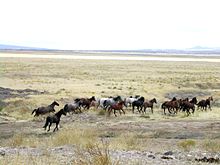
Modern horses were first brought to the Americas with the conquistadors, beginning with Columbus, who imported horses from Spain to the West Indies on his second voyage in 1493.[29] Horses came to the mainland with the arrival of Cortés in 1519.[30] By 1525, Cortés had imported enough horses to create a nucleus of horse-breeding in Mexico.[31]
One hypothesis held that horse populations north of Mexico originated in the mid-1500s with the expeditions of Narváez, de Soto or Coronado, but it has been refuted.[32][33] Horse breeding in sufficient numbers to establish a self-sustaining population developed in what today is the southwestern United States starting in 1598 when Juan de Oñate founded Santa Fe de Nuevo México. From 75 horses in his original expedition, he expanded his herd to 800, and from there the horse population increased rapidly.[33]
While the Spanish also brought horses to Florida in the 16th century,[34] the Choctaw and Chickasaw horses of what is now the southeastern United States are believed to be descended from western mustangs that moved east, and thus Spanish horses in Florida did not influence the mustang.[33]

Native American people readily integrated use of the horse into their cultures. They quickly adopted the horse as a primary means of transportation. Horses replaced the dog as a pack animal and changed Native cultures in terms of warfare, trade, and even diet—the ability to run down bison allowed some people to abandon agriculture for hunting from horseback.[36]
Santa Fe became a major trading center in the 1600s.[37] Although Spanish laws prohibited Native Americans from riding horses, the Spanish used Native people as servants, and some were tasked to care for livestock, thus learning horse-handling skills.[35] Oñate's colonists also lost many of their horses.[38] Some wandered off because the Spanish generally did not keep them in fenced enclosures,[39] and Native people in the area captured some of these estrays.[40] Other horses were traded by Oñate' settlers for women, or food and other goods.[33] Initially, horses obtained by Native people were simply eaten, along with any cattle that were captured or stolen.[41] But as individuals with horse-handling skills fled Spanish control, sometimes with a few trained horses, the local tribes began using horses for riding and as pack animals. By 1659, settlements reported being raided for horses, and in the 1660s the "Apache"[f] were trading human captives for horses.[42] The Pueblo Revolt of 1680 also resulted in large numbers of horses coming into the hands of Native people, the largest one-time influx in history.[40]
From the Pueblo people, horses were traded to the Apache, Navajo and Utes. The Comanche acquired horses and provided them to the Shoshone.[43] The Eastern Shoshone and Southern Utes became traders who distributed horses and horse culture from New Mexico to the northern plains.[44] West of the Continental Divide, horses distribution moved north quite rapidly along the western slopes of the Rocky Mountains, skirting desert regions[37] such as the Great Basin and the western Colorado Plateau.[44][g] Horses reached what today is southern Idaho by 1690.[35] The Northern Shoshone people in the Snake River valley had horses in 1700.[45][h] By 1730, they reached the Columbia Basin and were east of the Continental divide in the northern Great Plains.[35] The Blackfeet people of Alberta had horses by 1750.[46] The Nez Perce people in particular became master horse breeders, and developed one of the first distinctly American breeds, the Appaloosa. Most other tribes did not practice extensive amounts of selective breeding, though they sought out desirable horses through acquisition and quickly culled those with undesirable traits.[citation needed] By 1769, most Plain Indians had horses.[45][47]
In this period, Spanish missions were also a source of stray and stolen livestock, particularly in what today is Texas and California.[48] The Spanish brought horses to California for use at their missions and ranches, where permanent settlements were established in 1769.[47] Horse numbers grew rapidly, with a population of 24,000 horses reported by 1800.[49] By 1805, there were so many horses in California that people began to simply kill unwanted animals to reduce overpopulation.[50] However, due to the barriers presented by mountain ranges and deserts, the California population did not significantly influence horse numbers elsewhere at the time.[47][i] Horses in California were described as being of "exceptional quality".[50]
In the upper Mississippi basin and Great Lakes regions, the French were another source of horses. Although horse trading with native people was prohibited, there were individuals willing to indulge in illegal dealing, and as early as 1675, the Illinois people had horses. Animals identified as "Canadian", "French", or "Norman" were located in the Great Lakes region, with a 1782 census at Fort Detroit listing over 1000 animals.[52] By 1770, Spanish horses were found in that area,[35] and there was a clear zone from Ontario and Saskatchewan to St. Louis where Canadian-type horses, particularly the smaller varieties, crossbred with mustangs of Spanish ancestry. French-Canadian horses were also allowed to roam freely, and moved west, particularly influencing horse herds in the northern plains and inland northwest.[52]
Although horses were brought from Mexico to Texas as early as 1542, a stable population did not exist until 1686, when Alonso de León's expedition arrived with 700 horses. From there, later groups brought up thousands more, deliberately leaving some horses and cattle to fend for themselves at various locations, while others strayed.[53] By 1787, these animals had multiplied to the point that a roundup gathered nearly 8,000 "free-roaming mustangs and cattle".[54] West-central Texas, between the Rio Grande and Palo Duro Canyon, was said to have the most concentrated population of feral horses in the Americas.[46] Throughout the west, horses escaped human control and formed feral herds, and by the late 1700s, the largest numbers were found in what today are the states of Texas, Oklahoma, Colorado, and New Mexico.[46]

An early 19th-century reference to mustangs by American sources came from Zebulon Pike, who in 1808 noted passing herds of "mustangs or wild horses". In 1821, Stephen Austin noted in his journal that he had seen about 150 mustangs.[55][j]
Estimates of when the peak population of mustangs occurred and total numbers vary widely between sources. No comprehensive census of feral horse numbers was ever performed until the time of the Wild and Free-Roaming Horses and Burros Act of 1971 and any earlier estimates, particularly prior to the 20th century, are speculative.[56] Some sources simply state that "millions" of mustangs once roamed western North America.[57][58] In 1959, geographer Tom L. McKnight[k] suggested that the population peaked in the late 1700s or early 1800s, and the "best guesses apparently lie between two and five million".[46] Historian J. Frank Dobie hypothesized that the population peaked around the end of the Mexican–American War in 1848, stating: "My own guess is that at no time were there more than a million mustangs in Texas and no more than a million others scattered over the remainder of the West."[60] J. Edward de Steiguer[l] questioned Dobie's lower guess as still being too high.[62]
In 1839, the numbers of mustangs in Texas had been augmented by animals abandoned by Mexican settlers who had been ordered to leave the Nueces Strip.[63][64][m] Ulysses Grant, in his memoir, recalled seeing in 1846 an immense herd between the Nueces River and the Rio Grande in Texas: "As far as the eye could reach to our right, the herd extended. To the left, it extended equally. There was no estimating the number of animals in it; I have no idea that they could all have been corralled in the state of Rhode Island, or Delaware, at one time."[66] When the area was ceded to the U.S. in 1848, these horses and others in the surrounding areas were rounded up and trailed north and east,[67] resulting in the near-elimination of mustangs in that area by 1860.[65]
Farther west, the first known sighting of a free-roaming horse in the Great Basin was by John Bidwell near the Humboldt Sinks in 1841. Although John Charles Fremont noted thousands of horses in California,[68] the only horse sign he spoke of in the Great Basin, which he named, was tracks around Pyramid Lake, and the natives he encountered there were horseless.[69][n] In 1861, another party saw seven free-roaming horses near the Stillwater Range.[71] For the most part, free-roaming horse herds in the interior of Nevada were established in the latter part of the 1800s from escaped settlers' horses.[68][72][73]
In the early 1900s, thousands of free-roaming horses were rounded up for use in the Spanish–American War[74] and World War I.[75]
By 1920, Bob Brislawn, who worked as a packer for the U.S. government, recognized that the original mustangs were disappearing, and made efforts to preserve them, ultimately establishing the Spanish Mustang Registry.[76] In 1934, J. Frank Dobie stated that there were just "a few wild [feral] horses in Nevada, Wyoming and other Western states" and that "only a trace of Spanish blood is left in most of them"[77] remaining. Other sources agree that by that time, only "pockets" of mustangs that retained Colonial Spanish Horse type remained.[78]
By 1930, the vast majority of free-roaming horses were found west of Continental Divide, with an estimated population between 50,000 and 150,000.[79] They were almost completely confined to the remaining United States General Land Office (GLO)-administered public lands and National Forest rangelands in the 11 Western States.[80] In 1934, the Taylor Grazing Act established the United States Grazing Service to manage livestock grazing on public lands, and in 1946, the GLO was combined with the Grazing Service to form the Bureau of Land Management (BLM),[81] which, along with the Forest Service, was committed to removing feral horses from the lands they administered.[citation needed]
By the 1950s, the mustang population dropped to an estimated 25,000 horses.[82] Abuses linked to certain capture methods, including hunting from airplanes and poisoning water holes, led to the first federal free-roaming horse protection law in 1959.[83] This statute, titled "Use of aircraft or motor vehicles to hunt certain wild horses or burros; pollution of watering holes"[84] popularly known as the "Wild Horse Annie Act", prohibited the use of motor vehicles for capturing free-roaming horses and burros.[85] Protection was increased further by the Wild and Free-Roaming Horses and Burros Act of 1971 (WFRHABA).[86]
The Wild and Free-Roaming Horses and Burros Act of 1971 provided for protection of certain previously established herds of horses and burros. It mandated the BLM to oversee the protection and management of free-roaming herds on lands it administered, and gave U.S. Forest Service similar authority on National Forest lands.[56] A few free-ranging horses are also managed by the United States Fish and Wildlife Service[87] and the National Park Service,[88] but for the most part they are not subject to management under the Act.[89] A census completed in conjunction with passage of the Act found that there were approximately 17,300 horses (25,300 combined population of horses and burros) on the BLM-administered lands and 2,039 on National Forests.[90]

The BLM has established Herd Management Areas to determine where horses will be sustained as free-roaming populations.[91] The BLM has established an Appropriate Management Level (AML) for each HMA, totaling 26,690 bureau-wide,[92][93][94] but the on-range mustang population in August 2017 was estimated to have grown to over 72,000 horses,[95] expanding to 88,090 in 2019.[92]
More than half of all free-roaming mustangs in North America are found in Nevada (which features the horses on its State Quarter), with other significant populations in California, Oregon, Utah, Montana, and Wyoming.[96][o] Another 45,000 horses are in holding facilities.[95]
Bugatti theme by DeftoneUK
Download: Bugatti.p3t
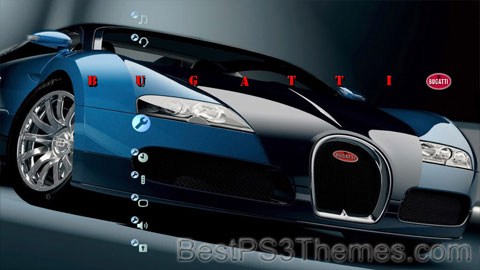
(8 backgrounds)
This article needs additional citations for verification. (October 2009) |
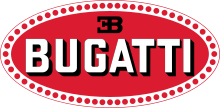 | |
| Company type | Private |
|---|---|
| Industry | Automotive |
| Founded | 1909 |
| Founder | Ettore Bugatti |
| Defunct | 1963 |
| Fate | Sold to Hispano-Suiza (1963)[1] |
| Headquarters | Molsheim, Alsace , France |
Key people |
|
| Products | Automobiles |
Automobiles Ettore Bugatti was a German then French manufacturer of high-performance automobiles. The company was founded in 1909 in the then-German city of Molsheim, Alsace, by the Italian-born industrial designer Ettore Bugatti. The cars were known for their design beauty and numerous race victories. Famous Bugatti automobiles include the Type 35 Grand Prix cars, the Type 41 "Royale", the Type 57 "Atlantic" and the Type 55 sports car.
The death of Ettore Bugatti in 1947 proved to be a severe blow to the marque, and the death of his son Jean in 1939 meant that there was no successor to lead the factory with no more than about 8,000 cars made. The company struggled financially, and it released one last model in the 1950s before eventually being purchased for its airplane parts business in 1963.
In 1987, an Italian entrepreneur bought the brand name and revived it as Bugatti Automobili S.p.A.[2]

The founder Ettore Bugatti was born in Milan, Italy, and the automobile company that bears his name was founded in 1909 in Molsheim located in the Alsace region which was part of the German Empire from 1871 to 1919. The company was known both for the level of detail of its engineering in its automobiles, and for the artistic manner in which the designs were executed, given the artistic nature of Ettore's family (his father, Carlo Bugatti (1856–1940), was an important Art Nouveau furniture and jewelry designer).

During the war Ettore Bugatti was sent away, initially to Milan and later to Paris, but as soon as hostilities had been concluded he returned to his factory at Molsheim.[3] Less than four months after the Versailles Treaty formalised the transfer of Alsace from Germany to France, Bugatti was able to obtain, at the last minute, a stand at the 15th Paris motor show in October 1919.[3] He exhibited three light cars, all of them closely based on their pre-war equivalents, and each fitted with the same overhead camshaft 4-cylinder 1,368cc engine with four valves per cylinder.[3] Smallest of the three was a "Type 13" with a racing body (constructed by the Bugatti themselves) and using a chassis with a 2,000 mm (78.7 in) wheelbase.[3] The others were a "Type 22" and a "Type 23" with wheelbases of 2,250 and 2,400 mm (88.6 and 94.5 in) respectively.[3]

The company also enjoyed great success in early Grand Prix motor racing: in 1929, a privately entered Bugatti won the first ever Monaco Grand Prix. Bugatti's racing success culminated with driver Jean-Pierre Wimille winning the 24 hours of Le Mans twice (in 1937 with Robert Benoist and in 1939 with Pierre Veyron).
Bugatti cars were extremely successful in racing. The little Bugatti Type 10 swept the top four positions at its first race. The 1924 Bugatti Type 35 is one of the most successful racing cars - developed by Bugatti with master engineer and racing driver Jean Chassagne who also drove it in the car's first ever Grand Prix in 1924 Lyon.[4] Bugattis swept to victory in the Targa Florio for five years straight from 1925 through 1929. Louis Chiron held the most podiums in Bugatti cars, and the modern marque revival Bugatti Automobiles S.A.S. named the 1999 Bugatti 18/3 Chiron concept car in his honour. But it was the final racing success at Le Mans that is most remembered—Jean-Pierre Wimille and Pierre Veyron won the 1939 race with just one car and meagre resources.


In the 1930s, Ettore Bugatti got involved in the creation of a racer airplane, hoping to beat the Germans in the Deutsch de la Meurthe prize. This would be the Bugatti 100P,[5][6] which never flew. It was designed by Belgian engineer Louis de Monge who had already applied Bugatti Brescia engines in his "Type 7.5" lifting body.
Ettore Bugatti also designed a successful motorised railcar, the Autorail Bugatti.[7]
The death of Ettore Bugatti's son, Jean Bugatti, on 11 August 1939 marked a turning point in the company's fortunes as he died while testing a Type 57 tank-bodied race car near the Molsheim factory.[8]

World War II left the Molsheim factory in ruins and the company lost control of the property. During the war, Bugatti planned a new factory at Levallois, a northwestern suburb of Paris. After the war, Bugatti designed and planned to build a series of new cars, including the Type 73 road car and Type 73C single seat racing car, but in all Bugatti built only five Type 73 cars.
Development of a 375 cc supercharged car was stopped when Ettore Bugatti died on 21 August 1947. Following his death, the business declined further and made its last appearance as a business in its own right at a Paris Motor Show in October 1952.[9]
After a long decline, the original incarnation of Bugatti ceased operations in 1952.

Bugatti models are known to focus on design.[10] Engine blocks were hand scraped to ensure that the surfaces were flat so that gaskets were not required for sealing, and many of the exposed surfaces of the engine compartment featured guilloché finishes on them. Safety wires were threaded through most fasteners in intricately laced patterns. Rather than bolt the springs to the axles as most manufacturers did, Bugatti's axles were forged such that the spring passed through an opening in the axle, a much more elegant solution requiring fewer parts. Bugatti himself described his competitor Bentley's cars as "the world's fastest lorries" for focusing on durability. According to Bugatti, "weight was the enemy".[11]
| Prototypes | Racing cars | Road cars |
|---|---|---|
|
|
Relatives of Harold Carr found a rare 1937 Bugatti Type 57S Atalante when cataloguing the doctor's belongings after his death in 2009. Carr's Type 57S is notable because it was originally owned by British race car driver Earl Howe. Because much of the car's original equipment is intact, it can be restored without relying on replacement parts.[13]
On 10 July 2009, a 1925 Bugatti Brescia Type 22 which had lain at the bottom of Lake Maggiore on the border of Switzerland and Italy for 75 years was recovered from the lake. The Mullin Museum in Oxnard, California bought it at auction for $351,343 at Bonham's Rétromobile sale in Paris in 2010.
The company attempted a comeback under Roland Bugatti in the mid-1950s with the mid-engined Type 251 race car. Designed with help from Gioacchino Colombo, the car failed to perform to expectations and the company's attempts at automobile production were halted.
In the 1960s, Virgil Exner designed a Bugatti as part of his "Revival Cars" project. A show version of this car was actually built by Ghia using the last Bugatti Type 101 chassis, and was shown at the 1965 Turin Motor Show. Finance was not forthcoming, and Exner then turned his attention to a revival of Stutz.
Bugatti continued manufacturing airplane parts and was sold to Hispano-Suiza, also a former auto maker turned aircraft supplier, in 1963.[1] Snecma took over Hispano-Suiza in 1968. After acquiring Messier, Snecma merged Messier and Bugatti into Messier-Bugatti in 1977.


Italian entrepreneur Romano Artioli acquired the Bugatti brand in 1987, and established Bugatti Automobili S.p.A.. Artioli commissioned architect Giampaolo Benedini to design the factory which was built in Campogalliano, Modena, Italy. Construction of the plant began in 1988, alongside the development of the first model, and it was inaugurated two years later—in 1990.[14] By 1989, the plans for the new Bugatti revival were presented by Paolo Stanzani and Marcello Gandini, designers of the Lamborghini Miura and Lamborghini Countach.
The first production vehicle was the Bugatti EB110 GT which featured a 3.5-litre, 5-valve per cylinder, quad-turbocharged 60° V12 engine, a six-speed gearbox, and four-wheel drive. Stanzani proposed an aluminium honeycomb chassis, which was used for all early prototypes. He and president Artioli clashed over engineering decisions so Stanzani left the project and Artioli sought Nicola Materazzi to replace him in June 1990. Materazzi, who had been the chief designer for the Ferrari 288 GTO and Ferrari F40 replaced the aluminium chassis with a carbon fibre one manufactured by Aerospatiale and also altered the torque distribution of the car from 40:60 to 27:73. He remained Director until late 1992.[15][16] Racing car designer Mauro Forghieri served as Bugatti's technical director from 1993 through 1994.[17] On 27 August 1993, through his holding company, ACBN Holdings S.A. of Luxembourg, Romano Artioli purchased Lotus Cars from General Motors. Plans were made to list Bugatti shares on international stock exchanges.
Bugatti presented a prototype large saloon called the EB112 in 1993.
Perhaps the most famous Bugatti EB110 owner was seven-time Formula One World Champion racing driver Michael Schumacher who purchased an EB110 in 1994. Schumacher sold his EB110, which had been repaired after a severe 1994 crash, to Modena Motorsport, a Ferrari service and race preparation garage in Germany.
By the time the EB110 came to market, the North American and European economies were in recession. Poor economic conditions caused the company to fail and operations ceased in September 1995. A model specific to the US market called the "Bugatti America" was in the preparatory stages when the company ceased operations.
Bugatti's liquidators sold Lotus Cars to Proton of Malaysia. German firm Dauer Racing purchased the EB110 licence and remaining parts stock in 1997 in order to produce five more EB110 SS vehicles. These five SS versions of the EB110 were greatly refined by Dauer. The Campogalliano factory was sold to a furniture-making company, which became defunct prior to moving in, leaving the building unoccupied.[18] After Dauer stopped producing cars in 2011, Toscana-Motors GmbH of Germany purchased the remaining parts stock from Dauer.
Ex vice-president Jean-Marc Borel and ex-employees Federico Trombi, Gianni Sighinolfi and Nicola Materazzi established the B Engineering company and designed and built the Edonis using the chassis and engine from the Bugatti EB110 SS, but simplifying the turbocharging system and driveline (from 4WD to 2WD).[19]

Volkswagen Group acquired the Bugatti brand in 1998. Bugatti Automobiles S.A.S. commissioned Giorgetto Giugiaro of ItalDesign to produce Bugatti Automobiles's first concept vehicle, the EB118, a coupé that debuted at the 1998 Paris Auto Show. The EB118 concept featured a 408-kilowatt (555 PS; 547 bhp), W-18 engine. After its Paris debut, the EB118 concept was shown again in 1999 at the Geneva Auto Show and the Tokyo Motor Show. Bugatti introduced its next concepts, the EB 218 at the 1999 Geneva Motor Show and the 18/3 Chiron at the 1999 Frankfurt Motor Show (IAA).
Bugatti Automobiles S.A.S. began assembling its first regular-production vehicle, the Bugatti Veyron 16.4 (the 1001 PS super car with an 8-litre W-16 engine with four turbochargers) in September 2005 at the Bugatti Molsheim, France assembly "studio".[20][21] On 23 February 2015, Bugatti sold its last Veyron Grand Sport Vitesse, which was named La Finale.[22]
Germany theme by Elliott
Download: Germany.p3t
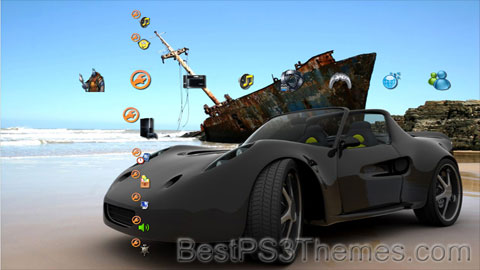
(1 background)
Federal Republic of Germany Bundesrepublik Deutschland (German) | |
|---|---|
| Anthem: "Das Lied der Deutschen"[a] ("The Song of the Germans") | |
Location of Germany (dark green) – in Europe (light green & dark grey) | |
| Capital and largest city | Berlin[b] 52°31′N 13°23′E / 52.517°N 13.383°E |
| Official languages | German[c] |
| Demonym(s) | German |
| Government | Federal parliamentary republic[4] |
| Frank-Walter Steinmeier | |
| Olaf Scholz | |
| Legislature | Bundestag, Bundesrat[d] |
| Area | |
• Total | 357,600 km2 (138,100 sq mi)[5] (63rd) |
• Water (%) | 1.27[6] |
| Population | |
• Q4 2023 estimate | |
• 2022 census | |
• Density | 236/km2 (611.2/sq mi) (58th) |
| GDP (PPP) | 2024 estimate |
• Total | |
• Per capita | |
| GDP (nominal) | 2024 estimate |
• Total | |
• Per capita | |
| Gini (2022) | low |
| HDI (2022) | very high (7th) |
| Currency | Euro (€) (EUR) |
| Time zone | UTC+1 (CET) |
• Summer (DST) | UTC+2 (CEST) |
| Date format |
|
| Driving side | right |
| Calling code | +49 |
| ISO 3166 code | DE |
| Internet TLD | .de |
Germany,[e] officially the Federal Republic of Germany (FRG),[f] is a country in Central Europe. It is the most populous member state of the European Union. Germany lies between the Baltic and North Sea to the north and the Alps to the south. Its 16 constituent states have a total population of over 84 million in an area of 357,600 km2 (138,100 sq mi). It borders Denmark to the north, Poland and Czechia to the east, Austria and Switzerland to the south, and France, Luxembourg, Belgium, and the Netherlands to the west. The nation's capital and most populous city is Berlin and its main financial centre is Frankfurt; the largest urban area is the Ruhr.
Settlement in what is now Germany began in the Lower Paleolithic, with various tribes inhabiting it from the Neolithic onward, chiefly the Celts. Various Germanic tribes have inhabited the northern parts of modern Germany since classical antiquity. A region named Germania was documented before AD 100. In 962, the Kingdom of Germany formed the bulk of the Holy Roman Empire. During the 16th century, northern German regions became the centre of the Protestant Reformation. Following the Napoleonic Wars and the dissolution of the Holy Roman Empire in 1806, the German Confederation was formed in 1815.
Formal unification of Germany into the modern nation-state commenced on 18 August 1866 with the North German Confederation Treaty establishing the Prussia-led North German Confederation later transformed in 1871 into the German Empire. After World War I and the German Revolution of 1918–1919, the Empire was in turn transformed into the Weimar Republic. The Nazi seizure of power in 1933 led to the establishment of a totalitarian dictatorship, World War II, and the Holocaust. After the end of World War II in Europe and a period of Allied occupation, in 1949, Germany as a whole was organized into two separate polities with limited sovereignty: the Federal Republic of Germany, generally known as West Germany, and the German Democratic Republic, known as East Germany, while Berlin continued its de jure Four Power status. The Federal Republic of Germany was a founding member of the European Economic Community and the European Union, while the German Democratic Republic was a communist Eastern Bloc state and member of the Warsaw Pact. After the fall of the communist led-government in East Germany, German reunification saw the former East German states join the Federal Republic of Germany on 3 October 1990.
Germany has been described as a great power with a strong economy; it has the largest economy in Europe. As a global power in industrial, scientific and technological sectors, it is both the world's third-largest exporter and importer. As a developed country it offers social security, a universal health care system, and tuition-free university education. Germany is a member of the United Nations, Council of Europe, NATO, OECD and a founding member of the European Union, G7, and G20. It has the third-greatest number of UNESCO World Heritage Sites.
The English word Germany derives from the Latin Germania, which came into use after Julius Caesar adopted it for the peoples east of the Rhine.[13] The German term Deutschland, originally diutisciu land ('the German lands') is derived from deutsch (cf. Dutch), descended from Old High German diutisc 'of the people' (from diot or diota 'people'), originally used to distinguish the language of the common people from Latin and its Romance descendants. This in turn descends from Proto-Germanic *þiudiskaz 'of the people' (see also the Latinised form Theodiscus), derived from *þeudō, descended from Proto-Indo-European *tewtéh₂- 'people', from which the word Teutons also originates.[14]
Pre-human ancestors, the Danuvius guggenmosi, who were present in Germany over 11 million years ago, are theorized to be among the earliest ones to walk on two legs.[15] Ancient humans were present in Germany at least 600,000 years ago.[16] The first non-modern human fossil (the Neanderthal) was discovered in the Neander Valley.[17] Similarly dated evidence of modern humans has been found in the Swabian Jura, including 42,000-year-old flutes which are the oldest musical instruments ever found,[18] the 40,000-year-old Lion Man,[19] and the 41,000-year-old Venus of Hohle Fels.[20][21] The Nebra sky disk, created during the European Bronze Age, has been attributed to a German site.[22]

The Germanic peoples are thought to date from the Nordic Bronze Age, early Iron Age, or the Jastorf culture.[23][24] From southern Scandinavia and northern Germany, they expanded south, east, and west, coming into contact with the Celtic, Iranian, Baltic, and Slavic tribes.[25]
Under Augustus, the Roman Empire began to invade lands inhabited by the Germanic tribes, creating a short-lived Roman province of Germania between the Rhine and Elbe rivers. In 9 AD, three Roman legions were defeated by Arminius in the Battle of the Teutoburg Forest.[26] The outcome of this battle dissuaded the Romans from their ambition of conquering Germania, and is thus considered one of the most important events in European history.[27] By 100 AD, when Tacitus wrote Germania, Germanic tribes had settled along the Rhine and the Danube (the Limes Germanicus), occupying most of modern Germany. However, Baden-Württemberg, southern Bavaria, southern Hesse and the western Rhineland had been incorporated into Roman provinces.[28][29][30]
Around 260, Germanic peoples broke into Roman-controlled lands.[31] After the invasion of the Huns in 375, and with the decline of Rome from 395, Germanic tribes moved farther southwest: the Franks established the Frankish Kingdom and pushed east to subjugate Saxony and Bavaria, and areas of what is today eastern Germany were inhabited by Western Slavic tribes.[28]


Knight Rider theme by jarheadusmc
Download: KnightRider.p3t
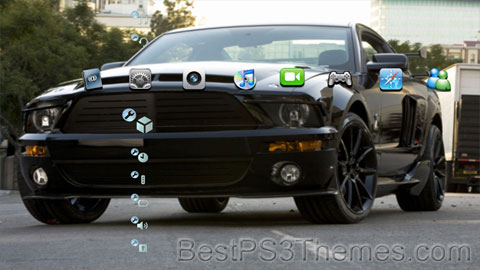
(7 backgrounds)
| Knight Rider | |
|---|---|
Franchise logo | |
| Created by | Glen A. Larson |
| Original work | Original series (1982) |
| Owner | Universal Studios |
| Films and television | |
| Film(s) | Knight Rider 2000 (1991) Knight Rider 2010 (1994) Knight Rider (2008) |
| Television series | Knight Rider (1982–1986) Team Knight Rider (1997–1998) Knight Rider (2008–2009) |
| Games | |
| Video game(s) | Knight Rider (1986) Knight Rider (1988) Knight Rider Special (1994) Knight Rider: The Game (2002) Knight Rider: The Game 2 (2004) |
Knight Rider is an American entertainment franchise created by Glen A. Larson. The core of Knight Rider is its three television series: the original Knight Rider (1982–1986) and sequel series Team Knight Rider (1997–1998) and Knight Rider (2008–2009). The franchise also includes three television films, a short-lived spinoff series, computer and video games, and novels, as well as KnightCon, a Knight Rider convention. Beginning with the original television series and continuing with the subsequent films and series, the franchise has developed a cult following and spawned many pop culture references.
The original Knight Rider series followed the adventures of Michael Knight, a modern-day crime fighter who uses a technologically advanced, artificially intelligent automobile. This car, named KITT, is virtually indestructible, due to a high-tech coating applied to it. Knight Rider stories usually depict either average citizens, or ethical heads of corporations, being bullied into subservience to an overbearing or ruthless criminal organization. The protagonist(s) of each particular series is instructed by the Foundation for Law and Government (FLAG) to assist in some manner. The protagonist(s) has the assistance of a high-tech, self-aware, and nearly indestructible vehicle.
The series debuted in 1982 and ran for four seasons on NBC. These adventures were continued with the television films Knight Rider 2000 and Knight Rider 2010 and the short-lived Team Knight Rider. One other television movie, Knight Rider, served as a pilot for the 2008 television series Knight Rider. In 1985, a spin-off series, Code of Vengeance, also premiered.
| Characters | Television series | Television films | ||||
|---|---|---|---|---|---|---|
| Knight Rider | Team Knight Rider | Knight Rider | Knight Rider 2000 | Knight Rider 2010 | Knight Rider | |
| Year of Release | 1982–1986 | 1997–1998 | 2008–2009 | 1991 | 1994 | 2008 |
| Michael Knight (Michael Arthur Long) |
David Hasselhoff | Body Double, Impersonator | David Hasselhoff | David Hasselhoff | ||
| KITT | William Daniels | Val Kilmer | William Daniels | Val Kilmer | ||
| KARR | Peter Cullen Paul Frees |
Peter Cullen | ||||
| Devon Miles | Edward Mulhare | Edward Mulhare | ||||
| Dr. Bonnie Barstow | Patricia McPherson | |||||
| April Curtis | Rebecca Holden | |||||
| Reginald Cornelius III ("RC3") | Peter Parros | |||||
| Russell Maddock | Carmen Argenziano | |||||
| Shawn McCormick | Susan Norman | |||||
| Knight Industries Four Thousand | Carmen Argenziano | |||||
| Thomas J. Watts | Mitch Pileggi | |||||
| Kyle Stewart | Brixton Karnes | |||||
| Jenny Andrews | Christine Steel | |||||
| Duke DePalma | Duane Davis | |||||
| Erica West | Kathy Trageser | |||||
| Kevin Sanders | Nick Wechsler | |||||
| Mike Traceur (Michael Knight, Jr.) |
Justin Bruening | Justin Bruening | ||||
| Dr. Sarah Graiman | Deanna Russo | Deanna Russo | ||||
| Dr. Charles Graiman | Bruce Davison | Bruce Davison | ||||
| Billy Morgan | Paul Campbell | Paul Campbell | ||||
| Jake McQueen | Richard Joseph Paul | |||||
| Hannah Tyrie | Heidi Hudson Leick | |||||
| Will McQueen | Michael Beach | |||||
| K.D. | Heidi Hudson Leick | |||||
| Wilton Knight (Richard Basehart) | Elizabeth (Bishop) Knight (Barbara Rush) | ||||||||||||||||||||||||||||||||||||||||
| Jennifer Traceur (Susan Gibney) | Michael Knight (David Hasselhoff) | Garthe Knight (David Hasselhoff) | Jennifer Knight (Mary Kate McGeehan) | ||||||||||||||||||||||||||||||||||||||
| Mike Traceur (Justin Bruening) | Jenny Andrews (Christine Steel) | ||||||||||||||||||||||||||||||||||||||||
Three television series make up the bulk of the Knight Rider mythos: Knight Rider (1982–1986), Team Knight Rider (1997–1998), and Knight Rider (2008–2009). There also was a spin-off series, Code of Vengeance, that ran for one season (1985–1986). In total, 133 Knight Rider episodes have been produced across the seven seasons of the four various TV series.
The original Knight Rider series saw Michael Knight (David Hasselhoff), a crime fighter who uses a high tech, artificially intelligent automobile, the Knight Industries Two Thousand (KITT). This car is a virtually indestructible weapon that fights for justice, and is voiced by actor William Daniels. The show was created and produced by Glen A. Larson, and was originally broadcast on NBC from 1982 to 1986. The show has 90 episodes over four seasons.
The two-part episode Knight Rider episode "Mouth of the Snake",[1] was a backdoor pilot for a 1984 series to be called All That Glitters. Rejected by NBC, the lead character and actor were recycled for a short-lived 1985–1986 series titled Code of Vengeance, in it, David Dalton (Charles Taylor), a Vietnam veteran-turned-drifter, travels across the United States in a camper van, with only his dog for company. Dalton involves himself in the personal lives of people he meets. In a similar fashion to Knight Rider, he uses his fighting skills to help them gain justice over their enemies. The Dalton character was retooled for the planned spin-off series, whose pilot, Code of Vengeance, was a surprise ratings success in June 1985. A subsequent series, to be called Dalton, was ordered by NBC for midseason, then production was cancelled after just four episodes were completed. These aired in the summer of 1986 as a television movie titled Dalton: Code of Vengeance II and as a part of a fill-in series called Dalton's Code of Vengeance.[2]
Team Knight Rider is set ten years after the original series, with the Foundation for Law and Government (FLAG) using a team of five "highly skilled operatives" to do the job that Michael Knight used to do. They are Kyle Stewart (Brixton Karnes), Jenny Andrews (Christine Steel), Duke DePalma (Duane Davis), Erica West (Kathy Trageser), and Kevin "Trek" Sanders, (Nick Wechsler). In one of the episodes it is implied that Jenny Andrews is the daughter of Michael Knight. However, it is never confirmed. The series was created by writer/producers Rick Copp and David A. Goodman, and was distributed by Universal Domestic Television. It ran for a single season of 22 one-hour episodes before it was canceled due to poor ratings.
The new Knight Rider series followed Michael "Mike" Traceur, the estranged son of Michael Knight, as he takes up the mantle of the FLAG driver. This time, he is driving the Knight Industries Three Thousand, also known as "KITT". The series stars Justin Bruening as Mike Traceur/Knight, and Deanna Russo as Sarah Graiman, Traceur's former girlfriend and love interest. Sarah is the daughter of Charles Graiman, played by Bruce Davison, the creator of a new generation of KITT, which is voiced by Val Kilmer. On May 19, 2009, NBC announced that Knight Rider was canceled after one season because of poor ratings.[3]
In 2016, it was announced that Machinima, YOMYOMF and NBCUniversal Brand Development are developing a Knight Rider reboot with Justin Lin producing and directing the series.[4][5] There has been no info about this since.
Knight Rider 2000 is a television sequel movie to the original Knight Rider series. It aired on May 19, 1991. It was directed by Alan J. Levi and written by Rob Hedden and Glen A. Larson. The movie sees Michael Knight (David Hasselhoff) teaming up once again with Devon Miles (Edward Mulhare) in a near future science fiction setting. He is also paired up with a new supercar, the "Knight 4000" to combat Thomas J. Watts (Mitch Pileggi), a former police officer turned psychotic killer. The movie also starred Susan Norman as Officer Shawn McCormick, and Carmen Argenziano as Russell Maddock (and the voice of the Knight 4000). The movie was developed as a pilot for a proposed new series, but despite high ratings, the plan was abandoned.
Knight Rider 2010 is a television movie loosely based on the original Knight Rider series. It aired on February 13, 1994. It was directed by Sam Pillsbury and written by John Leekley. The movie is set in a Mad Max-style future where Jake McQueen (Richard Joseph Paul) is a smuggler who is contacted by Hannah Tyree (Hudson Leick), an employee of the Chrysalis Corporation, who want him to work for them as part of their video games division. Jake fights the evil Jared (Brion James). Hannah's consciousness is uploaded into a computer that Jake then installs in his Mustang. The movie was broadcast as part of Universal Television's Action Pack.
Knight Rider is a 2008 television film which was created to serve as a backdoor pilot for the new Knight Rider television series, and aired on February 17, 2008. The serves as a direct sequel to the original series and ignores the Knight Rider 2000 film and the Team Knight Rider television series. It was directed by Steve Shill and written by David Andron and Glen A. Larson. The movie sees Mike Traceur (Justin Bruening) teaming up his childhood friend, Sarah Graiman (Deanna Russo), her father Charles Graiman (Bruce Davison), and Special Agent Carrie Rivai (Sydney Tamiia Poitier) to fight evil, he is paired up with a new KITT, the Knight Industries Three Thousand. The movie was a success and resulted in a new series.
Knight Rider is a 1986 video game by Ocean Software that was released in Europe for several computer platforms.
Knight Rider is a racing video game for the Nintendo Entertainment System that is very loosely based on the television show of the same name. It was developed by Pack-In-Video and published by Acclaim Entertainment. The game sees KITT having to travel between fifteen cities that are featured, starting with San Francisco and ending in Los Angeles.
Knight Rider Special (ナイトライダースペシャル, Naito Raidā Supesharu) is a video game for the PC-Engine based on the 1980s television series Knight Rider. It was produced by and published by Pack-In Video Co. Ltd on December 16, 1994 in Japan only. The game has a series of levels and each one requires that KITT be navigated through and around various cars, big rig trucks, and other obstacles in order to reach their destination on each level.
Knight Rider: The Game is a video game based on the original television series of the same name. It was developed by Davilex Games and distributed by Tri Synergy,[6] and was released on November 22, 2002. The game allows the player to take control of KITT – the Knight Industries Two Thousand, in a range of missions including, racing, exploring, chasing and others. The player also meets famous villains from the original series, including KARR and Garthe Knight.[7]
Knight Rider: The Game 2 is a video game sequel to Knight Rider: The Game, which was again developed by Davilex Games and was published by Koch Media on November 5, 2004, for PC and PlayStation 2.[8]
The Knight Rider franchise has a number of novels, video games, and other materials that cover many aspects of the various series and films.[9][10]
Various toy versions of KITT were released and produced solid profits. The more notable of the Knight Rider memorabilia includes the remote controlled KITT, the Knight Rider lunch box, and the deluxe version of KITT. This final model, sold by Kenner Toys and dubbed the "Knight Rider Voice Car", spoke electronically, using a recording of the voice of William Daniels, featured a detailed interior and a Michael Knight action figure as well.[11]
In the 1980s there was a Knight Rider toy vehicle for Germany's Darda system.[12]
Also in the 1980s a Key Car of KITT was released. But it had no scanner and the windows were black with "Knight 2000" written in red letter on the doors. It included a key which was pushed into a hole below KITTs spoiler compressing a spring; then snaps into place. Squeezing the key releases it and the spring shoots the car forward.
As with many popular series of the era (including The Dukes of Hazzard, The A-Team etc.), ERTL released die-cast toys of KITT in three different sizes – the common miniature model, a "medium" model, and a large model. These toys featured red reflective holograms on the nose to represent the scanner (however, they were located on the point of the nose, rather like the early mock-up of KITT seen in the pilot episode) as opposed to altering the basic model design to incorporate the scanner as commonly seen in the series. The toys also included round steering wheels as opposed to KITT's steering yoke.
Also in late 2004, 1/18 scale die-cast models of KITT and KARR were produced from ERTL, complete with detailed interior and illuminated moving scanner, just like in the series.[13]
In September 2006, Hitari, a UK-based company that produces remote control toy cars, released the Knight Rider KITT remote control car in 1/15 scale, complete with the working red scanner lights, KITT's voice from the television show and the car's turbine engine sound with the "whoosh whoosh" scanner sound effect.[14][15]
In December 2012, Diamond Select Toys released a talking electronic 1/15 scale KITT that features an illuminated dashboard, scanner, fog lights and tail lights, along with the original voice of KITT, William Daniels, all at a push of a button. An Entertainment Earth exclusive version of that Diamond Select Toys 1/15 KITT, exclusive, as it will include an in scale figure of Michael Knight to go with the car, was released in February 2013 and was available exclusively at Entertainment Earth's Web site. Diamond Select Toys will also was to be releasing an 8-inch figure of Michael Knight with the likeness of David Hasselhoff, which was to be released in March 2013.[16][17][18]
In February 2013, Hot Wheels released a 1/18 die-cast of KITT as part of their die-cast Elite series of vehicles under their Cult Classics Collection. This one from Hot Wheels was an improvement over the one ERTL released back in 2004. With sharper attention to details on the dashboard, the model features an improved light up red scanner, opening doors and rear hatch, as well as an engine hood which opens up to reveal a detailed Knight 2000 turbine engine which is exclusive to the model and was never shown in the TV series. Additional features include pop up headlights, revolving license plates, ejector seats, removable t-tops and a foldable rear seat.[19]
A "Fun Pack" based on Knight Rider for the toys-to-life video game Lego Dimensions was released in February 2017. The pack includes a Michael Knight minifigure and constructible KITT, and unlocks additional Knight Rider-themed content in the game.[20]
In 2016, Call of Duty: Infinite Warfare's "Zombies" mode features David Hasselhoff reprising his role as Michael Knight, appearing as the games map "Zombies in Spaceland"'s DJ. The Knight Rider theme plays in game and many references to the series and KITT are made.[citation needed]
In March 2002, Revolution Studios announced a partnership with Mayhem Pictures to create a film adaptation of the television series. The film would be re-designed to be similar to Revolution's previous project, XXX. Series creator Glen A. Larson was hired to write the first script draft, with the series' lead actor David Hasselhoff attached as an advisor and also have an onscreen role.[21] In April 2003, Revolution Studios hired screenwriters David Elliott and Paul Lovett to pen the film's script.[22] In April 2004, the premise of the film was described as having Hasselhoff reprise his role as Michael Knight, now the mentor to the protagonist as Devon Miles mentored Knight in the television series. The protagonist would be Knight's son, inheriting his father's role and driving the vehicle KITT. The producers' choice for the role was actor Ben Affleck.[23]
In May 2006, The Weinstein Company acquired film rights to adapt Knight Rider from series creator Larson. He expressed his interest in the film adaptation as a potential franchise property.[24] The following September, Hasselhoff invited actor Orlando Bloom to portray Knight's son in the film adaptation, but Bloom turned down the offer.[25] In April 2007, Hasselhoff said, that the film was in development at Miramax, and that he would at least have a cameo in the film.[26]
On June 26, 2013, Brad Copeland was writing a script for a Knight Rider film after beating out Travis Beacham, Alex Kurtzman and Roberto Orci.[27]
On February 13, 2014, Schmoes Know reported that actors Chris Pratt and Danny McBride were in talks for roles and may use a sort of action-comedy hybrid in the same vein as 21 Jump Street.[28]
In Dec
Ford Mustang Giugiaro Concept theme by stu2b2
Download: FordMustangGiugiaroConcept.p3t
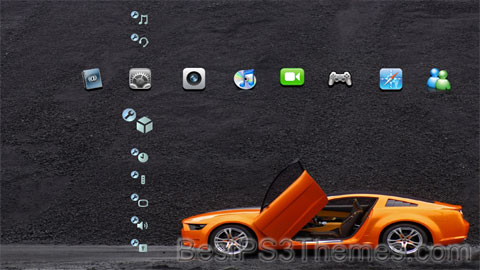
(7 backgrounds)
P3T Unpacker v0.12
Copyright (c) 2007. Anoop Menon
This program unpacks Playstation 3 Theme files (.p3t) so that you can touch-up an existing theme to your likings or use a certain wallpaper from it (as many themes have multiple). But remember, if you use content from another theme and release it, be sure to give credit!
Download for Windows: p3textractor.zip
Instructions:
Download p3textractor.zip from above. Extract the files to a folder with a program such as WinZip or WinRAR. Now there are multiple ways to extract the theme.
The first way is to simply open the p3t file with p3textractor.exe. If you don’t know how to do this, right click the p3t file and select Open With. Alternatively, open the p3t file and it will ask you to select a program to open with. Click Browse and find p3textractor.exe from where you previously extracted it to. It will open CMD and extract the theme to extracted.[filename]. After that, all you need to do for any future p3t files is open them and it will extract.
The second way is very simple. Just drag the p3t file to p3textractor.exe. It will open CMD and extract the theme to extracted.[filename].
For the third way, first put the p3t file you want to extract into the same folder as p3textractor.exe. Open CMD and browse to the folder with p3extractor.exe. Enter the following:
p3textractor filename.p3t [destination path]Replace filename with the name of the p3t file, and replace [destination path] with the name of the folder you want the files to be extracted to. A destination path is not required. By default it will extract to extracted.filename.
Mclaren Mercedes F1 theme by TKSLAM
Download: MclarenMercedesF1.p3t

(2 backgrounds)
P3T Unpacker v0.12
Copyright (c) 2007. Anoop Menon
This program unpacks Playstation 3 Theme files (.p3t) so that you can touch-up an existing theme to your likings or use a certain wallpaper from it (as many themes have multiple). But remember, if you use content from another theme and release it, be sure to give credit!
Download for Windows: p3textractor.zip
Instructions:
Download p3textractor.zip from above. Extract the files to a folder with a program such as WinZip or WinRAR. Now there are multiple ways to extract the theme.
The first way is to simply open the p3t file with p3textractor.exe. If you don’t know how to do this, right click the p3t file and select Open With. Alternatively, open the p3t file and it will ask you to select a program to open with. Click Browse and find p3textractor.exe from where you previously extracted it to. It will open CMD and extract the theme to extracted.[filename]. After that, all you need to do for any future p3t files is open them and it will extract.
The second way is very simple. Just drag the p3t file to p3textractor.exe. It will open CMD and extract the theme to extracted.[filename].
For the third way, first put the p3t file you want to extract into the same folder as p3textractor.exe. Open CMD and browse to the folder with p3extractor.exe. Enter the following:
p3textractor filename.p3t [destination path]Replace filename with the name of the p3t file, and replace [destination path] with the name of the folder you want the files to be extracted to. A destination path is not required. By default it will extract to extracted.filename.